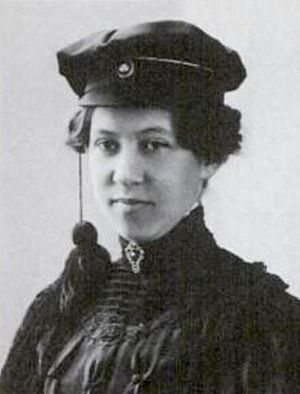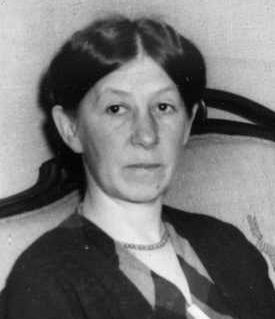Ellen Gleditsch facts for kids
Ellen Gleditsch (born December 29, 1879 – died June 5, 1968) was a brilliant Norwegian scientist. She was a pioneer in radiochemistry, which is the study of radioactive materials. Ellen became Norway's second female professor. She started her amazing career working with the famous scientist Marie Curie. Ellen helped figure out how long radium stays radioactive (its half-life). She also helped show that isotopes exist, which are different forms of the same element. Besides her science work, she also helped fight for women's rights.
Contents
A Scientist's Journey
Ellen Gleditsch was born in 1879 in Mandal, Norway. Even though she was a top student in high school, women couldn't take the college entrance exams back then. So, she started working as a pharmacy assistant. There, she studied chemistry and pharmacology and earned a special degree in 1902.
Studying in Paris and America
In 1905, with help from her mentor Eyvind Bødtker, Ellen passed the university entrance exam. But instead of studying in Norway, she chose to go to Paris. From 1907 to 1912, she studied radioactivity at the Sorbonne and worked in Marie Curie's laboratory.
At Curie's lab, Ellen used a special method called fractional crystallisations. This technique helped to make radium very pure. Her work was so skilled that she didn't have to pay for her lab fees! She spent five years working closely with Marie Curie. In 1911, she earned a science degree from the Sorbonne. She was then offered a teaching job at the University of Oslo.
After one year, Ellen won the first scholarship ever given to a woman from the American-Scandinavian Association. This allowed her to study in the United States. Even though two schools first turned her down, she went anyway!
Important Discoveries
Ellen was able to work at the lab of Bertram Boltwood at Yale University. There, she measured the half-life of radium. This measurement became a standard that was used for many years. One of the scientists who had first said no to her at Yale later wrote two articles with her. In June 1914, Smith College gave her an honorary doctorate for her important work.
From 1913 to 1914, she returned to the University of Oslo. In 1917, she became only the second woman to be chosen for Oslo's Academy of Science. In the 1920s, Ellen traveled to France many times to help Marie Curie. She also visited a mine in Cornwall to study it.
Helping Other Women Scientists
In 1919, Ellen Gleditsch helped start the Norwegian Women Academics' Association. This group focused on helping science grow and improving conditions for women scientists. She believed that scientists working together could also help create peace. She was the president of this group from 1924 to 1928.
In 1920, she joined the International Federation of University Women. She became its President from 1926 to 1929. In this role, she worked hard to create scholarships so women could study in other countries. In 1929, she traveled across the United States to promote these scholarships for women.
Professor and Wartime Hero
In 1929, Ellen became a professor at the University of Oslo. This caused some debate, but she successfully started a radioactivity research group there. Throughout the 1930s, she wrote many scientific articles in English, French, German, and Norwegian. She also hosted radio shows to make science popular and easy to understand.
In the 1930s, she led a radiochemistry lab in Norway. This lab secretly helped scientists who were escaping from the Nazi regime during the war. In 1939, she joined the International Committee on Intellectual Cooperation. Marie Curie had also been a member of this important committee. When Norway was taken over during the war, Ellen hid scientists in her home. She also continued doing experiments there. In 1943, during a raid on her lab, the women scientists managed to save the radioactive minerals. Sadly, all the men were arrested.
Later Years and Honors
Ellen retired from the university in 1946. She then started working with UNESCO, an organization that tries to end illiteracy around the world. In 1949, she was active on a special committee. In 1952, she joined the Norwegian group working to control the use of the atomic bomb. That same year, she left UNESCO. She did this to protest against Spain being allowed to join, as it was under a harsh government at the time.
In 1962, when she was 83 years old, she received another honorary doctorate from the Sorbonne. She was the first woman ever to receive such an honor from that university.
Honors and Awards
- In 1920, Ellen Gleditsch was awarded .
- In 1948, she received an honorary doctorate from the University of Strasbourg.
- In 1946, she was made a Knight of the 1st Class of the Order of St. Olav.
- In 1957, she became an honorary citizen of Paris.
- In 1962, she was named an honorary doctor at the University of the Sorbonne, as the first woman ever.
- In 1966, she was made an honorary member of the Norwegian Chemical Society.
- Oslo Municipality has named a road after her; it is located in the district Stovner in Oslo.
- In November 2018, OsloMet named a university building (P35) on the Pilstredet campus after her.
- In 2019, a street was named after her in her hometown of Mandal. Ellen Gleditsch road is located on Malmøy.
- In 2021, Radiumhospitalet's new cyclotron (a machine used in science) was named Ellen Gleditsch.
Works
- 'Ratio Between Uranium and Radium in the Radio-active Minerals', Comptes Rendus 149:267 (1909).
See also
 In Spanish: Ellen Gleditsch para niños
In Spanish: Ellen Gleditsch para niños



